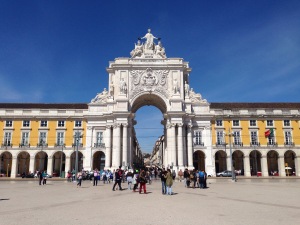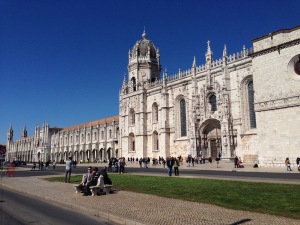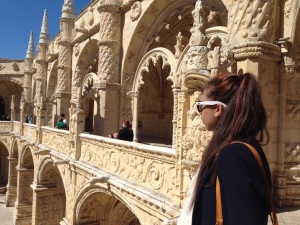Visit: 15th March 2015
Natalie and I visited Lisbon recently on a short weekend break, spending one night in the city but getting almost two days’ sightseeing out of it. We flew out out early on TAP (the Portuguese flag carrier) from Heathrow, arriving into Lisbon’s Portela Airport mid-morning. Unlike its neighbour, Spain, Portugal runs on the same time zone as Britain, which meant that we didn’t lose an hour on the outbound. The weather was warm, which made a pleasant contrast to London in mid-March; I believe it was in the region of 17°C, so we didn’t need coats.
After checking in to our hotel we took the metro into the centre and soon gravitated towards the Praça do Comércio, or Commerce Square, which is down by the waterfront. This large open space is surrounded on three sides by buildings including the attractive yellow facade containing the triumphal Rua Augusta Arch, above. An obvious focal point for tourists, we found ourselves being offered drugs several times here, as well as pestered for change by some of the innumerable beggars in the city. It did make me wonder why we didn’t see more of that kind of thing in Athens recently, since Greece has been worse hit by the Eurozone financial crisis than Portugal has – although both have obviously suffered.
Lisbon is a city of tramways, and it is evident from the wooden trams like the one above that the network could do with a bit of modernisation – these ‘Remodelados’ date back to the 1930s. Nevertheless, I should think the antique trams are probably a tourist attraction in themselves – so they are pretty to look at but probably not very comfortable for regular riders.
On Saturday we sought out and spent time eating and drinking at the excellent central food court – this is where we found the cheeses covered on my EU food blog here, here, here and here. We also ate at a croquette bar, before going to the National Museum of Ancient Art. In addition to lots of works by obscure Portuguese artists, we saw paintings by Dürer (St. Jerome in His Study) and Hieronymus Bosch (the Temptation of St. Anthony).
 It was on Sunday that we headed out west to the suburb of Belém in order to visit the World Heritage Site consisting of a monastery and nearby tower. The journey started off okay, on a busy but modern tram. But halfway there the tram stopped and the driver ordered everybody off, suggesting we wait for a bus to take us the rest of the way. We chose to walk it, and a couple of kilometres later we met the reason for the diverted tram: a military parade going on and a marching band.
It was on Sunday that we headed out west to the suburb of Belém in order to visit the World Heritage Site consisting of a monastery and nearby tower. The journey started off okay, on a busy but modern tram. But halfway there the tram stopped and the driver ordered everybody off, suggesting we wait for a bus to take us the rest of the way. We chose to walk it, and a couple of kilometres later we met the reason for the diverted tram: a military parade going on and a marching band.
Portugal’s most famous pastry product is surely the Pastel de nata, which is a kind of custard tart. The best ones are apparently sold in cafes near the monastery, because the monks used to get through so much egg white starching their habits that they became proficient at turning the unwanted yolk into custard tarts. Having had a few pastels de nata in the city centre we were able to discern the increase in quality at the pastelaria A Chique de Belem (go here if you ever find yourself in Belém looking for a pastry, as opposed to the more famous nearby pastelaria Pastéis de Belém, which we admittedly didn’t go into but which was so busy it had a queue to enter with a bouncer funneling people in and out).
The nearby Monastery of the Hieronymites is a popular tourist destination in Lisbon, but was not excessively busy when we visited. We were able to nip into the church just before it closed for mass, then we queued up and paid our entry fee to see the cloister. You don’t really get to visit much more than the central cloister at this monastery, along with a couple of side rooms. There are two stories, upstairs and downstairs, with walkways surrounding a central grass square.
The monastery is notable for the ornateness of the walls and columns, as you can see in the photos.
The Portuguese were the first Europeans to explore the globe. Ships first set off in the 15th century. The Monastery of the Hieronymites was built to honour the accomplishments of Vasco de Gama and Prince Henry the Navigator. It was de Gama who discovered a direct sailing route to India via the Cape of Good Hope – the southern tip of Africa. The monastery was started in 1502 by Prince Henry’s grandson, King Manuel I, and took nearly a hundred years to complete. It is after Manuel that the Manueline style in named, and it is synonymous with the Portuguese Age of Discovery. The interior of the Church of Santa Maria, located within the monastery building, is a good example of that style.
A fifteen minute walk from the monastery (and across a busy highway) stands the Tower of Belém (Belém is a corruption of the Portuguese word for Bethlehem). The tower was commissioned as a part of Lisbon’s defence system, and is again in the Manueline style. It is built in the water, a couple of metres out from the shoreline, and has been used in anger a number of times over the years.
The WHS of Sintra lies not far from Lisbon, but unfortunately it was a little far for us to manage on our brief weekend visit. I look forward to returning to the city in a few years time on my way to Sintra, as well as perhaps going east to the WHSs of Elvas and Évora – home of my favourite Portuguese cheese.









Alway interesting reading Tom. Mention of Pastel de nata brings back particularly pleasant memories of visits to Portugal (and the Adores) Tim Pardoe
Sent from my Sony Xperia Z on O2
Thanks Tim – I hope you will tell my parents of this because we’re just organising a family trip to Lisbon and surrounding area for December and I want them to look forward to the food!
Pingback: • University of Coimbra – Alta and Sofia | Tom's World Heritage Site travel blog
Pingback: • Cultural Landscape of Sintra | Tom's World Heritage Site travel blog
Pingback: • Historic City of Toledo | Tom's World Heritage Site travel blog
Pingback: • Abbey of St Gall | Tom's World Heritage Site travel blog
Pingback: • Poblet Monastery | Tom Livesey's World Heritage Site blog